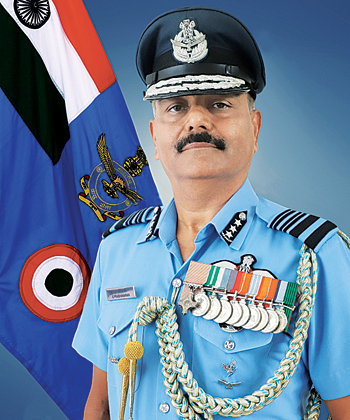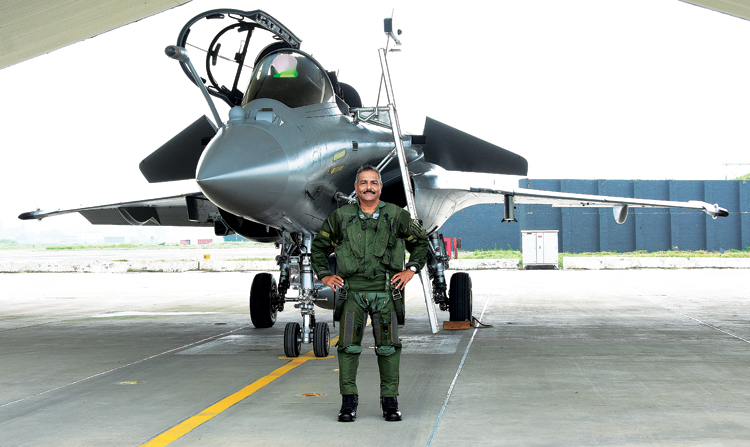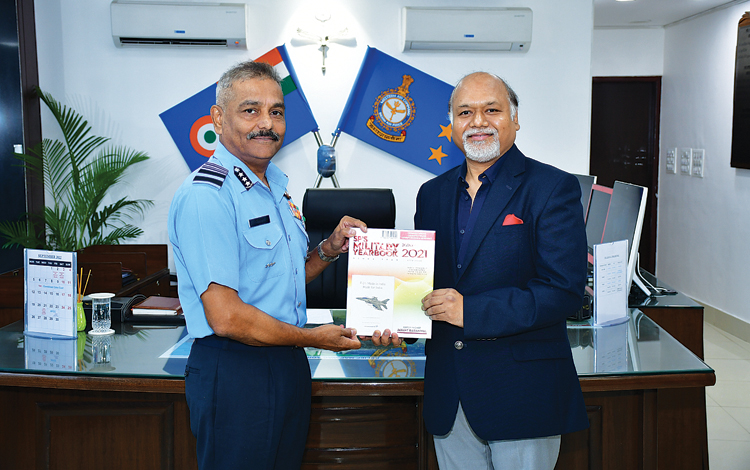INDIAN ARMED FORCES CHIEFS ON
OUR RELENTLESS AND FOCUSED PUBLISHING EFFORTS

SP Guide Publications puts forth a well compiled articulation of issues, pursuits and accomplishments of the Indian Army, over the years

I am confident that SP Guide Publications would continue to inform, inspire and influence.

My compliments to SP Guide Publications for informative and credible reportage on contemporary aerospace issues over the past six decades.
EXCLUSIVE
“We have to constantly stay alert and ready, since both our neighbours are less than friendly”
Air Marshal Sreekumar Prabhakaran, Air Officer Commanding-in-Chief, Western Air Command, Indian Air Force speaks to SP’s Aviation on the challenges regularly faced by the Air Warriors under his command

SP’s Aviation (SP’s): What is your broad vision for forces under your command and what are the core focus areas?
Air Marshal S. Prabhakaran (Prabhakaran): The WAC area of responsibility has been under continuous stress for the past three years. You are aware that we were on a state of high alert after the strike at Balakot and then after the clash at Galwan.
We need to be ready to handle aggression on both, the western border with Pakistan and the north-eastern border with China. We need to strengthen our air power to counter these two adversaries.
We have to work on the induction and operationalisation of new equipment, while trying to maintain a high serviceability status of legacy equipment. I have to strike a fine balance between maintaining a high alert state and training for the various combat roles envisaged. Our personnel are also constantly turning over. So, balancing these requirements is the challenge. Any Air Force which has superior technology will have an overwhelming advantage in any conflict. The Rafale aircraft is now a key component of India’s firepower in the skies, being capable of a range of operations. In addition, procurements of the C-17 and C-130J transport aircraft, Apache & Chinook helicopters, S-400 Air Defence Missile Systems and a large number of indigenous weapons, sensor and systems, are steps in that direction. Therefore, what I’m concentrating on is to identify issues that are impacting our operational capability and can be addressed in the immediate future and then use all resources at my disposal to provide a solution to my combat and combat support elements.
SP’s: Aerial warfare evolves consistently. Technologically and in terms of doctrines, too. Would you like to share your thoughts on the evolution and as to how our armed forces plan to co-op with the pace and process of evolution?
Prabhakaran: The Indian Air Force has a rich history of excellence in aerial warfare. In the Indian sub-continent, we’ve been one of the forerunners. As far as evolving our doctrine and training with advancements in technology is concerned, I agree with you that the technology is evolving at a rapid pace with Artificial Intelligence enabling all facets of warfighting. The future may belong to Al enabled planning process tasking networked forces with Manned Unmanned Team (MUMT) components, prosecuting campaigns under an overall integrated Network Centric Warfare (NCW) umbrella. Our armed forces, and in particular the IAF, have initiated multiple steps to imbibe the benefits of Al in our processes. Some of these initiatives are in the public domain. To give you an example, not long ago, IAF threw open a competition for private sector developers of Unmanned Aerial Systems (UAS) to showcase their wherewithal in building and deploying Swarm Drones. The results of this competition were encouraging not only for the participants but also for the IAF as it gave us the confidence to look at home-grown solutions for Al based Swarm Drones for our requirements.
“The future may belong to Al enabled planning process tasking networked forces with Manned Unmanned Team (MUMT) components, prosecuting campaigns under an overall integrated Network Centric Warfare (NCW) umbrella”
The home-grown military aviation industry is rapidly evolving with development of AMCA not too far into the future. Very soon our armed forces will be able to boast of a large component of indigenous components of warfighting with cutting edge technology. Our equipment profile, though varied, already reflects a transformation of IAF into a potent Air Force. Our Air Defence and Offensive elements are now well integrated in a seamless manner. Our Air Defence setup got a shot in the arm with the induction of the S-400 Surface to Air Missile system to complement the existing indigenous Akash systems. We are now truly capable of Area Defence.
SP’s: Jointmanship assumes great importance in modern warfighting. Can you indicate on the steps being initiated to nurture and build on the same?
Prabhakaran: Let me tell you, that actually Western Air Command (WAC) is the perfect example of the use of airpower and Jointmanship. WAC deals with four different Army Commands and is able to manage its warplans, air maintenance and all peacetime activities by using the same assets, both combat and support, wherever they are required. There have been no problems and the field units of all services will attest the immediate response of the IAF and the high level of Jointmanship that already exists. As regards joint operations, there is no doubt that there needs to be a body that carries out joint planning at the highest level. We have an opportunity to reform, so it is very important that we are able to exploit fully the strengths of the IAF and that we get this process absolutely right.
SP’s: The Line of Actual Control (LAC) has witnessed enhanced activities in the past two years. How has the Western Air Command responded to these developments?
Prabhakaran: You are very right in your assessment about the responsibilities of Western Air Command. We have to constantly stay alert and ready, since both our neighbours are less than friendly in their approach. We maintain a high state of readiness on both fronts. Our forces are deployed and available and are capable of swinging to any front, depending on where the situation develops, be it the deserts of Rajasthan, Punjab, Jammu & Kashmir or the Himalayas of Ladakh. We train continuously and keep our combat elements ready to respond at very short notice. We are in a position to immediately respond to any LAC violation or any air activity which is against the laid down CBMs between the two sides.
SP’s: Humanitarian Assistance & Disaster Relief (HADR) operations have been assuming great importance, in the past one year. How have air assets been deployed from your command?
Prabhakaran: IAF is the first responder towards HADR operations. Meticulous planning is carried out to cover the vast areas of the nation and respond to mercy calls in any part of the nation. My area of responsibility mostly covers hilly and mountainous terrain and the calls for mercy missions and HADR relief ops are frequent. We have been providing immediate and effective relief to all the needy and will continue to do so. Our immediate response to the recent landslides near Badrinath is an example.

HADR during Floods/Cloud Burst. The procedure for deployment of assets is as given below:
- Though, heptr and transport assets are always on standby to undertake emergency evacuations and CASEVAC missions; these assume greater significance during the period of high probability which include HADR relief ops during monsoons. Additional assets are earmarked to launch on short notice from centralised hubs like Hindon, Sarsawa, Chandigarh, Palam, Jammu, Srinagar and Suratgarh. These bases standby to cover the entire WAC. Similarly, other bases are also put on standby to cover the entire nation. On requirement basis these assets are positioned anywhere in the country.
- On activation of HADR ops, ops centers are activated at all the affected bases which are participating in the relief ops. A Task Force Commander (TFC) is nominated who acts as a nodal contact point for all the tasking and relief ops. He also maintains a close liaison with the civil administration to meet all the requirements arising as the situation builds up.
Operation Shiva: Following the cloud burst near the Amarnath cave, HADR was activated for evacuation of injured and insertion of relief supplies and teams to the affected areas. With terrain considerations and prevailing weather for positioning of additional resources, 8 helicopters were activated for relief operations.
“The induction of AH-64E Apache Attack Helicopter has led to a quantum leap in the capability of IAF and has established itself as a game changer in the current context”
A total of 107 sorties were flown and 132 casualties were rescued. NDRF personnel, media personnel and relief load was inducted near the Holy Cave. In order to ensure aerospace safety, a team of five IAF personnel headed by the Task Force Commander was inducted to Panchtarni, to oversee the operations, immediate requirements of sorties and safety of all flying heptrs in close vicinity of each other. There were more than 14 heptrs flying in the restricted area close to Holy Cave which included IAF, IA and civil helicopters.
COVID-19 relief operations: IAF aircraft and aircrews flew virtually nonstop for days on end towards timely positioning of critical medical supplies and equipment. C-17 fleet flew in 133 Cryogenic two Tankers from abroad besides airlifting 712 two Tankers within the country. IL-76 fleet was deployed for transporting O2 Plants across the country. The ever reliable An-32 fleet pitched in by transporting medical equipment including O2 Concentrators, Ventilators, O2 Masks, COVID-19 Testing Kits, etc.
Operation Devi Shakti: The IAF was called upon for emergency evacuation of Indian nationals from Afghanistan following the withdrawal of NATO forces from the country in August 2021. C-17 aircraft of 81 squadrons were launched on short notice under extremely challenging conditions for the task. 456 Indian nationals were evacuated from the conflict zone during the Operation.
Operation Ganga: Following the Russian invasion of Ukraine in February 2022, the IAF was called upon for emergency evacuation of Indian nationals from the Ukrainian warzone through neighboring countries viz. Romania, Hungary, Poland and Slovakia. My C-17 fleet undertook round the clock operations under trying conditions to evacuate 2,826 Indian nationals from the warzone.
SP’s: What are the implications of having newly acquired Apache helicopters in the operation capability calculus?
Prabhakaran: The induction of AH-64E Apache Attack Helicopter has led to a quantum leap in the capability of IAF and has established itself as a game changer in the current context. The helicopter has proved its high altitude capability while being deployed in Eastern Ladakh since June 2020. The Pilot Night Vision System (PNVS) is based on FLIR technology which makes it capable of 24 x 7 operations, whereas the other helicopter flying on NVGs need ambient light for operating at night.
The Apache is the ideal platform to be utilised in close air support to army formations and numerous exercises have been conducted to validate the same. The helicopter is also able to operate with ALH SI and SF elements of the Indian Army. The helicopter is capable of carrying out ‘Hot Refueling and Rearming’ resulting in better sortie generation rates and improved revisit times.

The Helicopter comes with modern avionics which includes the Longbow FCR which is utilised for acquisition of aerial or ground targets leading to superior Situational Awareness and battlefield transparency. The Radio Frequency Interferometer (RFI) is a passive sensor which can be utilised in conjunction with the FCR for identifying, classifying and pin pointing emitting radars accurately. This along with an advanced EW suite, consisting of RWR, MAWS and CMDS, has greatly improved the survivability of the helicopter in the TBA. The improvements in the airframe have also led to enhancement in crashworthiness of the helicopter. In addition to the above, the helicopter has advanced data-linking capability between formation members and to the Ground Control Station (GCS) which is a step ahead towards Network Centric Warfare.
The helicopter can precisely engage ground targets using AGM-114 Hellfire. Apache is also able to accurately take on targets using 70mm rockets and 30mm nose gun from standoff ranges that offer the aircraft adequate safety from AD weapons. The Air-to-Air Stinger would make it the only helicopter capable of engaging aerial targets which has greatly improved its survivability against aerial threats.
SP’s: What measures are being adopted to provide impetus to the Atmanirbhar Barat Scheme?
Prabhakaran: Towards Atmanirbhar Bharat initiative, IAF is actively involved with Defence PSUs, Industry, Start-ups and Academia to steer us forward. BRDs are also helping in the indigenisation process. This is an ongoing process and we are confident of making rapid progress.
SP’s: Regional Connectivity Scheme – Ude Deshka Aam Nagrik (RCSUDAN) is one of the flagship schemes of the Minister of Civil Aviation (MoCA). Could you reflect how the AF has been contributing towards this effort?
Prabhakaran: IAF has been pro-actively contributing towards RCS-UDAN scheme. Many IAF bases have been opened up for undertaking civil operations as and when the proposals are received from MoCA. As on date proposals for civil aircraft operations from 39 bases in IAF and 13 in WAC AoR have been cleared. Watch hours of bases i.e., Chandigarh, Jammu and Srinagar have been enhanced as per civil aviation requirements in WAC.
SP’s: Having commanded the Surya Kiran Aerobatic Team (SKAT) as a Wing Commander, you have continued to be very closely associated with the team and continue to mentor. What are the future aspirations for the team?
Prabhakaran: It was indeed my privilege to command the Surya Kiran Aerobatic Team from 2002 to 2005. I had a fantastic team of selected pilots and technicians under me. For the first time, the IAF had then sent us to an international airshow (Asian Aerospace, Singapore 2004). And I think we contributed significantly to showcase lAFs professionalism and bring a sense of pride to our countrymen. Since then, succeeding teams have represented the lAF in various parts of the country and abroad, including at the Dubai airshow. After my command I was closely associated with team as a mentor and ensured that the display profile has undergone a thorough review in terms of safety aspects and visual appeal. As the mentor of the present team, I am proud of the boys under their present Commanding Officer, Group Captain Anoop Singh. Remember, they are one of the very few 9-aircraft aerobatic teams in the world. They are truly ambassadors of the IAF.





